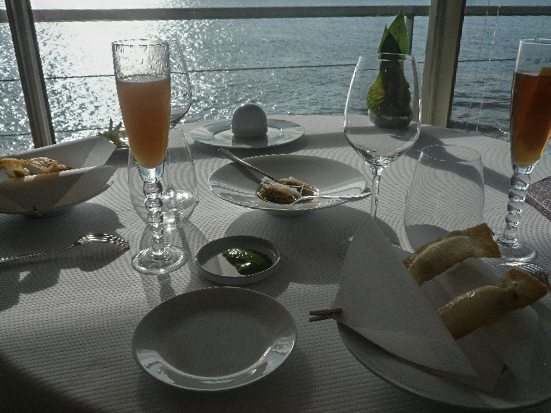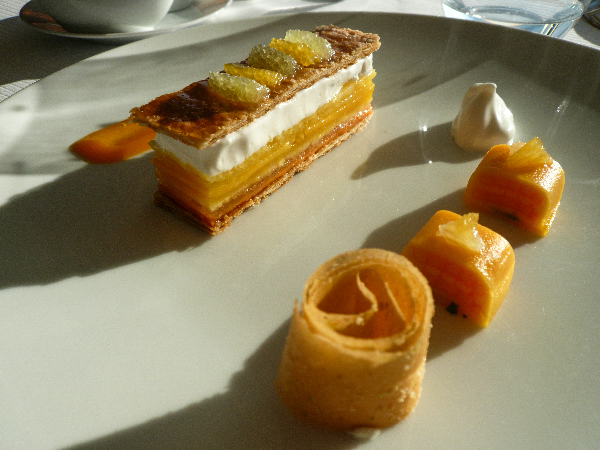Sometimes traditional dishes are not that good. This is particularly the case with fish soups. Some version of fish soup exists in all Mediterranean countries. Their common problem is that, while the broth is often tasty, the fish gets overcooked. If you want a great, but non-traditional bouillabaisse, I recommend one restaurant in Marseille: Le Petit Nice.
Le Petit Nice is the only three starred restaurant in the close vicinity of Marseille. Some claims that Michelin accorded three stars to Petit Nice due to political reasons. I disagree, based on my own experience. The service, wine list, surroundings, product quality, conceptualization, execution, etc., are all first rate and what I would expect from a Michelin three starred restaurant. Perhaps most important is the fact that Petit Nice, despite its misleading name, is a restaurant which is rooted in a particular place (Marseille) and terroir. The cooking is not international in style, but the chef seeks out superior products that you cannot find in the best of your local markets and possibly in the best fish markets of Marseille. The quality of the fish is outstanding, and so is the cooking. If you arrive there with your car, the gate will open and you can park in front of the restaurant/boutique hotel. The reception is warm and welcoming. They seat you with a smile, and you are given the menu without a delay. I found the service to be on par with the food. The team is professional, and they are clearly proud to serve the exquisite food. When they serve each dish, they give just the right amount of information. If you have further questions, they respond without any hint of impatience. The waiting time between the courses is optimum, neither too much or nor do you feel pressed and in a hurry. You can relax and savor the nice aromas. At any rate, it is impossible not to feel in heaven in front of such a quintessential Mediterranean rocky sea view and in such a comfortable, understated, but very classy setting. It is delightful.
Of particular interest was an athletic man who swam in free style for about 45 minutes in the sea, which, in December, must not have exceeded 13 degree celsius. When he jumped from the rocks, like a goat, and came closer to put on his shirt, I noticed that he did not have any fat and looked in great shape. But he was not that young. It turned out that he was in the second part of 80s and a good friend of Monsieur Passedat’s father. Chapeau! I later noticed that the name Passedat was given to a street near the restaurant. Clearly this is an old Marseillais family.
In a good, sunny day (such as we had in early December), you can begin by sipping excellent house-made cocktails. I selected a cocktail with champagne, syrup of ginger, and red martini. Linda naturally opted for something sweeter, champagne with lychee, mandarin liquors, and fresh pineapple. The typical wine with bouillabaisse is a Cassis blanc, but think a racy Chablis with nice acidity and a crisp finish is a better bet. After a brief conversation with a gentleman who may be the director of the dining room, or sommelier, or both, we both agreed that the 2006 Jean-Marc Raveneau Valmur Grand Cru Chablis would make a nice complement. The only non-local ingredient Passedat offers is olive oil, and for good reason. There are very good olive oils in Provence, but the very best olive oils come from Italy and Tuscan olive oils are in a class on their own. Passedat has selected a remarkable olive oil, probably recently pressed (green hues), and serves it with excellent focaccia and bread. The attention given to such details should be a hallmark of three starred restaurants, but, unfortunately, not all of them operate at such high standards. With our cocktails they offered extremely fresh chopped sepia, with a touch of ginger, mango, and coriander. It was very nice and refreshing.

The other amuse was the beignet of local small white fish. I was really taken aback by the quality of deep frying, as I have tried some tempura masters in Tokyo. The tarragon puree dip was also light and had the right acidity. Battered and deep fried fish with a dip is a much abused universal classic. Try it here to see how such a simple dish can be elevated to a regal status.

The chef sends us more amuses before the beginning of the bouillabaisse feast. We were first served a raw Mediterranean fish (Liche?) with rose radish, celery leaves, and apple slices. Everything was extremely fresh. This was followed by a consommé of lobster with ginger and basil and a Cancale oyster.
Before serving the first course of the bouillabaisse, they showed us the daurade royale stuffed with vegetables and herbs (bay leaves) that was cooked in the oven. The beautiful aroma of the sweet and smoky fish titillated our taste buds.
The first course consists of a carpaccio of shellfish served with an artichoke and chive dip. The clam and mussel carpaccio is seasoned with olive oil, salt, and lemon just right, and it is not only visually stunning, but it is also delightful and light.

The chef sends a few of beignets to accompany the carpaccio, including a beignet of artichokes, a beignet from a small fish from the sar family, and another from a small fish that I could not identify. When I inquired about chef’s skills in deep frying, we were told that the fish jus is used in the light batter. I am quite curious about the oil used in deep frying, since the beignets are so flavorful and light.
The dips that accompany the tempura are always based on herbs (fish jus and artichoke pieces in one) and add the right amount of acidity to the salty/crunchy texture of the beignets.
Before the next two courses, you are served a carrot puree with verjus sorbet to cleanse the palette.
The next course consisted of St Pierre (John Dory) and daurade royal (sea bream) in a light fish/shellfish broth containing a good amount of saffron, coriander and julienned vegetables (celery and celery leaves). The chef also included two pieces of sweet lobster tail.
The key to quality is the fact that the fish is cooked separately from the broth. This way it becomes possible to serve the fish at the precise texture and temperature and to use the soup as saucing. The turbot-like texture of the St. Pierre and the lighter, more flakey texture of the daurade contrasted beautifully, the cooking was precise, and the natural flavors of the fish and shellfish were not lost in a mishmash. When asked about how the lobster was cooked, because it was remarkably juicy, we were told that it was first seared in the oven and then steamed.


The last course consisted of a heavier, very rich broth of bouillabaisse served with the same daurade royale and Mediterranean sea bass or loup de mer. Unfortunately, in the modern world, it is nearly an impossible task to find wild sea bass which has not also eaten the stuff fed to farmed sea bass. It has a very delicate, refined, and exquisite texture.
The broth of this course was richer and darker than the previous course, and it contained an equal amount of saffron. We were told that sea water and algues were also used. So this is the French-Marseillais version of dashi.
Monsieur Passedat does not serve classical rouille or aioli with his bouillabaisse because he does not want to mask the natural fresh taste of the fish. Instead he serves a side dish of slightly hot tomato (his rouille), grated reggiano, and cubed potatoes, instead of croutons.

They recommended millefeuille after the rich, deep and complex bouillabaisse, and this also turned out to be exquisite. It is basically an exotic millefeuille, with papaya, mango, and pineapple, in various forms and guises.

If you have room left, the confit fruits and the jewelry box that they offer with your dark coffee are also captivating.


2006 Chablis Valmus – Jean-Marc Ravenau
The nose started to yield minerality, earthy, and fresh agrumes components. It has a very good structure and refreshing acidity, buttressed by fruit, including classic Chardonnay fruits, like pear and apple. The finish is long. You almost chew the steely minerality in the finish. It is still a baby, but giving pleasure. It is a great match with the food.
Grade: 96






I thought bouillabaisse was feminine
We are heading there in 2 weeks, very looking forward! Some great pics & a good article!